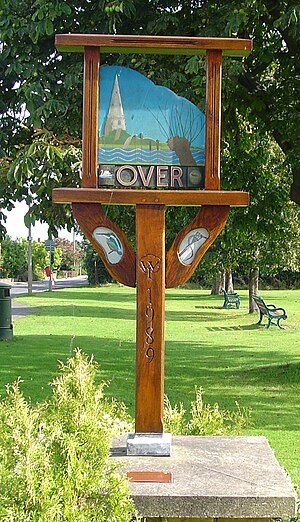Over
Template:Infobox town 2 Over is a large village near the River Great Ouse in Cambridgeshire, just east of the Greenwich Meridian. It is to be found equidistant from two county towns, Cambridge and Huntingdon, 10 miles from each. The village has a clutch of local shops, a primary school, shop, two public houses (the Admiral Vernon and the Exhibition) and a parish church, St Mary's. In recent years, the village has expanded rapidly, with the inclusion of several housing estates, a community and conference centre and modern sporting facilities. An Over day centre was set up in 1989 and the Over Community Centre in 1999.
The name of the village is the Old English Ofer, meaning riverbank.
Over End
Over End was once a separate hamlet from Over, but now largely integrated. It forms the south-eastern part of today's High Street, running towards the village green.
St Mary's Church
The parish church is St Mary's Church. It is built almost entirely of Barnack stone, the rich, orange limestone once quarried at Barnack in Northamptonshire that graces Peterborough Cathedral and the many pretty villages of the Soke of Peterborough.
St Mary's has traces of 14th century work, including flower-ball carvings, gargoyles representing birds and beasts, and a south porch of perfect proportions. Its size shows the income the village received from, among other things, the Suffolk wool trade and goods sold in the market at St Ives.
Unlike many Fenland and edge-of-fen churches, St Mary's, Over is highly ornamented, which is evidence of the amount of money which was available at the time of construction and decoration: the more complicated the work, the more it cost.
There are also two other churches in Over: a Methodist church in the Lanes, which was built in 1848 and features a typical one storey design found in Methodist churches, and a Baptist church in New Road built directly onto a house, whose owner gave the land for the church to be built in 1737.
History

Some archaeologists believe that the ridge of slightly higher land upon which the village stands was the furthest intrusion inland of the sea — unlike the villages in the fens, which were often surrounded by watery land after the sea receded. Over was an edge-of-fen settlement.
By 1628 the fens and meres to the north of the settlement were enclosed, as was the rest of the village land by 1837.
Originally, there were two distinct settlements. One was around St Mary's Parish Church, the other at Over End – the south-eastern part of today's High Street running towards the village green.
When it comes to buildings, Over is a village full of contrast both in terms of age and designs. Although the exact date is unknown, a row of old thatched cottages on the north side of the High Street were burned to the ground during a fire started by an arsonist. These were replaced by the large Victorian houses which feature balconies to the front.
Many of the old houses in the village are Victorian, as the majority of the older clunch and wattle cottages have been demolished.
The influence of the Dutch who, under the leadership of the engineer Vermuyden, came to drain the Fens, can be seen in several of Over's older houses – The Old Black Horse in the High Street and the Ivy House in Fen End are the most obvious, with their rounded end-walls and angled brick-ties.
The town hall stands in the High Street opposite Overcote Road. Over the door is inscribed the date MDCCCXLIX (1849), and it bears also some marks made to show how high flood waters have reached in past years.
Apart from the parish church, the oldest remaining structure in Over now is believed to be the wall running down Fen End from the Willingham Road corner. The small patch of wall, now incorporated into newer brickwork, was believed by the late Ernie Papworth to have stood for over 500 years.
Outside links
| ("Wikimedia Commons" has material about Over) |
